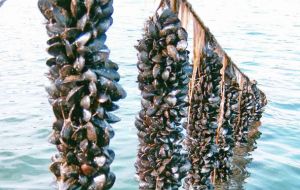MercoPress. South Atlantic News Agency
Galicia closes a third of mussel polygons because of resurgent bio-toxic red tide
 Mussel farms are a common sight along the Galician coast
Mussel farms are a common sight along the Galician coast The Xunta of Galicia in the northwest of Spain banned the extraction of mussels in 18 of the 55 floating nurseries of the autonomous region, that is to say, in 32% of the total capacity because of the presence of lipophilic biotoxin.
The red tide had diminished last July, but in recent days has again peaked. Last week, 12 of the 18 mussel polygons affected with the bio-toxin were closed, reported the newspaper La Voz de Galicia.
Last Thursday, the Galician authorities banned the sale of bivalves that are farmed in four aquaculture parks: three in O Grove (C1, C2 and C4) and one in Cangas (Cangas C); and this Tuesday six centers located in Cangas (Cangas F, Cangas G, Cangas H) and in Bueu were closed.
Currently according to the latest reports the red tide has extended to the estuaries of Sada, O Grove, Baiona, Corme-Laxe, Pontevedra and Vigo.
The lipophilic toxin is safe for seafood, but in humans it causes serious digestive disorders issues and diarrhea.
According to Galicia's Secretariat of the Sea, it would be premature to decide how much and far the red tide will advance and whether or not it will be worse than the one that hit the sector in 2013.
At present, the local government decided to distribute 1.5 million Euros among the mussel producers, and anticipated that the beneficiaries will receive 60% of the money they lost or are losing because of the current red tide spell.

![“Working directly with President [Donald] Trump and Congress, we accomplished what no one else could,” Patel stressed](/data/cache/noticias/108417/130x80/fbi.jpg)


Top Comments
Disclaimer & comment rules-

Read all commentsIt seems this phenomenom there is far less dangerous than tha red tide we suffer here in Magallanes were the bio-toxine is deadly if those affected with it aren´t treated son enough. This bio-toxine haven´t effects on the holder bivalves, so it can´t be discovered just sighing them, so a laboratory test is required and here we have not bivalves farms so the fishermen have to catch them on the channel shores that we have in a big quantity even very far from the main cities of the Región de Magallanes. In the Región de los Lagos they have bivalves farm and they have suffered red tide attacks but like in Galicia with no casualties.
Aug 14th, 2014 - 02:40 am 0At the moment. and after a lot of years of studies and investigation, have not been discovered the final cause of the production of this bio-toxine by the bivalves, but it´s influenced by the sea water salinity and temperature, movement of the tides and other parameters, so it has very high variability and the fishing and health authorities must do continuous control trips around the catching áreas to ensure that the level of contamination is under the dangerous ones and each arrival of bivalves catch to every ports must give a test simple of it to the health authority to get a certificate for the lot to be sold at the fish & shelfish shops to the people. Another caractheristic of this bio-toxine is that it´s not eliminated even under cooking so the only way to exploit those contamined catching areas is to wait for the natural decrease that could happens eventually in the future by changes in the sea water conditions.
We have had this problem for a long time ago so we are used to live with it.
Some historians have proposed that the Spaniards that arrived to the Magallanes Strait with Pedro Sarmiento de Gamboa to establish a colony on it´s shores on 1584 suffered with the red tide considering that the bivalves were their main food, after their supplies from Spain were eaten and ammunition for hunting shooted, which leads them to death.
Commenting for this story is now closed.
If you have a Facebook account, become a fan and comment on our Facebook Page!